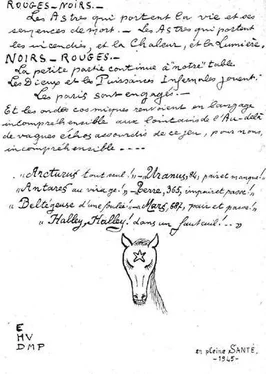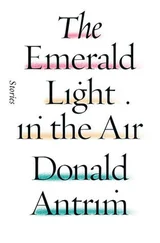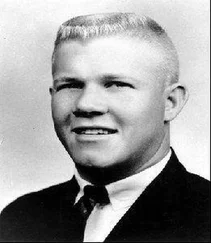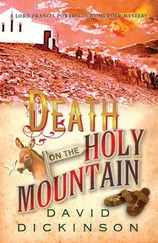But who could say how many bodies lay in the pit? With a depth estimated at ten to twelve feet, there were clearly many more here than in the basement. The bones crunched under Massu’s foot on landing. When the commissaire exited, reeking from his descent, he ordered specialists to retrieve the bones for analysis at the police laboratory. His assistants, however, refused. They looked as frightened, Massu said, as if they expected a bomb to explode or had met the devil himself.
Commissaire Massu had made some 3,257 arrests in his thirty-three-year career investigating crime in the French capital, but he had never seen a case as heinous or as perplexing as this one. Who was responsible for this “nightmare house”? Who, for that matter, were the victims, how many were there, and how exactly had they died? Most perplexing of all, what was the motive? The murderer—whoever he was—was not just killing his victims, he was dismembering them. The attempt to solve what Massu soon dubbed “the crime of the century” had begun.
1.
GERMAN NIGHT
THE GERMAN NIGHT HAS SWALLOWED UP THE COUNTRY.…
FRANCE IS NOTHING BUT A SILENCE; SHE IS LOST SOMEWHERE IN THE NIGHT WITH ALL LIGHTS OUT.
—Antoine de Saint-Exupéry, letter to the New York Times Magazine , November 29, 1942
FOUR years before, many of Paris’s richest and most privileged residents had begun fleeing the capital. The duke of Windsor; Prince George of Greece; Princess Winnie de Polignac and her niece, Daisy Fellowes, the heiress to the Singer sewing fortune, had all departed. The Aga Khan set out for Switzerland. Peggy Guggenheim stored her art collection in a friend’s barn and drove away in her Talbot, in the direction of the Haute Savoie ski resort of Megève.
Not far behind were a number of writers, painters, and artists who had turned the City of Light into what New York Times art critic Harold Rosenberg called “the laboratory of the twentieth century.” James Joyce left for a village outside Vichy before continuing into Zurich. Gertrude Stein and Alice B. Toklas departed for Culoz, near Annecy. Marc Chagall, Henri Matisse, René Magritte, and Wassily Kandinsky headed south. Vladimir Nabokov secured the last ocean liner to New York. Walter Benjamin hiked across a mountain passageway into Spain, but made it no farther than Portbou, where he committed suicide at age forty-eight.
The scale of departures from the French capital had accelerated in May 1940 with the Nazi invasion of Belgium, Luxembourg, and the Netherlands. On the afternoon of June 3, when the air raid sirens began to wail, the Luftwaffe pounded the Renault and Citroën factories, the bombs also falling onto the Air Ministry on Boulevard Victor. The one-hour raid left a trail of street craters, massive piles of rubble, and a block of apartment buildings looking, as journalist Alexander Werth put it, “like a badly-cut piece of cheddar.” Two hundred and fifty-four people had been killed and another six hundred and fifty-two injured.
As the Nazi Wehrmacht advanced closer to the capital, nearly encircling it from the north, the east, and the west, the exodus soon reached epic proportions. Trains were booked far beyond capacity, forcing many Parisians to leave by motorcar, truck, horse-drawn cart, hearse, or any other contraption. More often, residents fled on foot, pushing selected personal belongings, from mattresses to birdcages, onto bicycles, motorcycles, prams, wheelbarrows, oxcarts, hay wains, coffee vendor carts—virtually anything with wheels.
Legions of refugees struggled, under the hot summer sun, against almost completely blocked roads, under the occasional strafing of the Luftwaffe and, after Mussolini declared war on June 10, the attacks of Italian planes. Automobiles were abandoned for lack of gasoline. Rumors thrived in the oppressive climate of heat and hunger, feeding on the painful memories of the First World War and the feelings of uncertainty that swirled around the present crisis. No one knew when, or if, they would be able to return home.
Of France’s forty million people, an estimated six to ten million inhabitants clogged the roads. Paris saw its population fall from nearly three million to about eight hundred thousand. The mass exodus was replicated in cities all over northern and eastern France, as the population headed south or southwest. The pilot and future author of The Little Prince , Antoine de Saint-Exupéry, peering down from his observation mission on the 2/33 Reconnaissance Squadron, thought that the mass movements looked like “a boot had scattered an ant-hill,” sending the unfortunate refugees dispersing “without panic. Without hope, without despair, on the march as if in duty bound.”
Beginning on June 9, the French government itself fled the capital. Heading south, first to Orléans and then to the châteaux of the Loire, the leaders retreated to Bordeaux. Five days after their flight, the first German motorcyclists reached Paris, rolling into the Place Voltaire from the northern suburbs of Saint-Denis. By the early afternoon, the Nazi Wehrmacht had staged the first of its daily marches goose-stepping to drum and fife down an otherwise silent Avenue des Champs-Élysées. “There never has been anything like the eerie atmosphere in Paris,” Robert Murphy observed from his office at the United States Embassy on the Place de la Concorde.
At least sixteen people in Paris took their own lives that day. The neurosurgeon and head of the American Hospital, Comte Thierry de Martel, stuck his arm with a syringe filled with strychnine. Novelist Ernst Weiss, Franz Kafka’s friend, swallowed a large amount of barbiturates, but when this overdose failed to have its intended effect, he slashed his wrists, dying twenty-four hours later. The sixty-four-year-old concierge at the Pasteur Institute, Joseph Meister, shot himself in the head rather than obey the German invaders—he had been the first person cured of rabies by Louis Pasteur.
Many Parisians were in shock. What the German army under the kaiser had failed to do in four years of vicious slaughter in the First World War had been accomplished under Adolf Hitler in six weeks. France had suffered the most humiliating defeat in its history. Worse, however, was to come.
THE Germans would occupy three-fifths of the country, seizing a vast swath of territory north of the Loire that included two-thirds of France’s population, two-thirds of its most fertile agricultural lands, and three-fourths of its industry. The occupying power would control not only Paris but also the strategic Atlantic and Channel coastlines. France would have to pay the costs of the German Occupation, which were set at an exorbitant daily rate of 400 million francs and pegged to an inflated 20–1 franc-mark exchange rate. Over the next four years, France would pay the Third Reich a total of 631,866,000,000 francs, or almost 60 percent of its national income.
The rest of France was to be carved up. Germany seized Alsace and Lorraine, as well as the northeastern territories of the Nord and Pas-de-Calais, the latter governed by Wehrmacht Command in Brussels, with entrance strictly forbidden to Frenchmen. A slice of territory from Menton to the southeastern border was handed over to Germany’s ally, Italy. The remaining part, located south of the Loire, became the “free” or the unoccupied zone, a nominally independent state with its capital in Vichy, a spa and casino resort known for its mineral water. When the French government had resettled there in the summer of 1940, it had to acknowledge “the rights of the occupying power.” Collaboration—once a benign word for “working together”—soon took on a sinister new meaning.
In Paris, the Blitzkrieg was rapidly followed by a Ritzkrieg. Nazi officials arrived en masse to take control of the capital and commandeer prime real estate in the elegant western districts. The High Command of the German Military Occupation, which would govern the occupied zone, moved into the Hôtel Majestic on avenue Kléber. The Kommandant , or governor-general, of Grand-Paris, chose the Hôtel Meurice on rue de Rivoli; the military intelligence and counterespionage organization, the Abwehr (Abwehrstelle Frankreichs), set up headquarters in the Hôtel Lutétia nearby on the Boulevard Raspail. The Luftwaffe took over the Palais Luxembourg, while the Kriegsmarine settled into various properties on and around the Place de la Concorde.
Читать дальше












